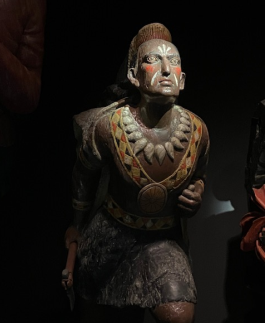MYSTIC SEAPORT—A REAL TREAT, HIPPOCAMPUS AND NATIVE HISTORY!
- argold57
- Jun 15, 2023
- 2 min read
Too often residents do not really take part in the cultural and historical aspects of their hometowns, and Norma is guilty of that. She only visited Mystic Seaport for academic pursuits, especially when she had an American Literature and the Sea graduate class here with Nathaniel Philbrick (In the Heart of the Sea) as her teacher. Mystic Seaport is world famous for its Charles Morgan, the only actual whaling ship on display in the U.S., and the Amistad (replica, built for the movie) slave ship which is currently moored here for future renovations.

The Seaport is an actual working shipyard and houses many boats of all types as well as a dozen museums and displays and planetarium, etc. One gets more than a boat ride for admission, and it certainly was time for us to get a family membership so our grandkids could enjoy what the Seaport has to offer.
We enjoyed a tour of the Fire Fighter which helped out in New York during 911, as well as a members’ tour of the shipyard where Norma ogled a real Viking ship with beautiful wooden lines.
The Seaport has so much to offer, especially if you are able to walk around easily, go up and down stairs and just enjoy the many shops and displays. Allen especially like the shipyard tour where the facilitator was extremely knowledgeable and enjoyed our questions.

Norma loves museums and especially Native American history since she works with many tribal colleges. The two top photos above picture a museum oddity, a hippocampus, or seahorse, carved in 1897. It was originally part of the Dentzel Carousel Company in Philadelphia.
Among a dazzling display of ship figureheads was the depiction of a Seminole Indian warrior who did not accurately represent any actual indigenous person, but his bared chest and legs, bear-claw necklace, and the ax in his hand perpetuated the false idea that Native Americans were more savage than Europeans, a non-fact we locals know about especially from the local history of the Pequot War 1636-7, a lowlight of which was a massacre of mostly 500 Native women and children in the dead of night by John Mason’s crew. The Pequot War was a 3-year war (actually a series of massacres and not a war at all), instigated by the Puritans to seize the tribes’ (Pequot/ Wunnashowatuckoogs/Narragansett and other local tribes’ traditional land. As a former runner, I knew to spit on Mason's statue every time I ran by it, one of the local traditions that finally got the statue removed.
I have to commend the Seaport in not hiding the truth of the Europeans’ barbarism. In almost every display, the truth of our history is laid bare and is very clear about who the original settlers and natives were and what was done to dispossess them of their cultural homelands.
What we hope to remember best here is how interested Allen and I both were in so many educational and nautical aspects of Mystic Seaport and the relative joy we had in watching the wildlife—seagulls, ducks, swan, and geese, (lots of geese) and their goslings parade around the lovely Mystic River in which the Seaport is one of its shining neighbors.








Comments